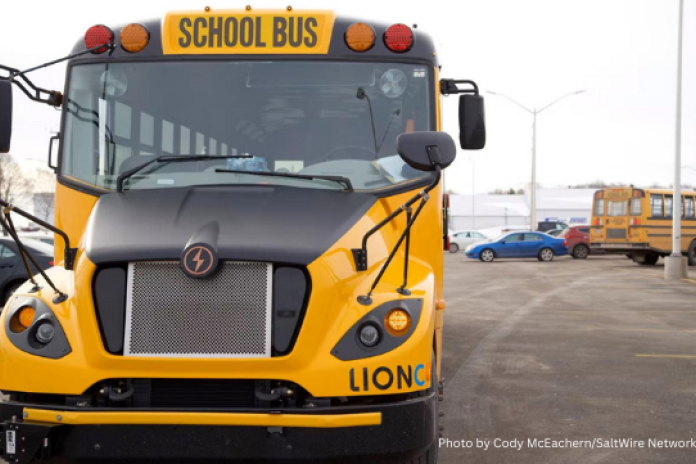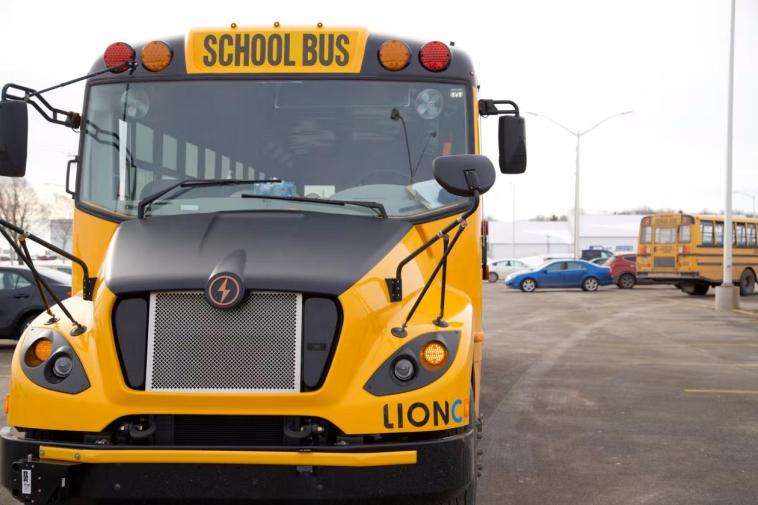Electric School Bus Progress From our Northern Neighbors in Prince Edward Island, Canada

In collaboration with partners and communities, WRI’s Electric School Bus Initiative aims to build unstoppable momentum toward an equitable transition of the U.S. school bus fleet to electric, bringing health, climate and economic benefits to children and families across the country and normalizing electric mobility for an entire generation. The Electric School Bus Series shows how superintendents and fleet managers across the United States have pursued school bus electrification in their own communities. This edition covers Prince Edward Island, Canada, which provides a useful example for how government policy and financial support can combine to drive school bus fleet electrification and is especially relevant for school districts in cold climates and with drivers who take buses home between routes.
This piece is based off an interview with Mike Franklin, Transportation Supervisor for the Prince Edward Island Public Schools Branch.
As the United States witnesses rising electric school bus adoption — a 57% increase in committed electric school buses between June and December of 2021 — decision makers can look to their northern neighbor, Prince Edward Island (PEI), as a potential model for implementation.
Although PEI is Canada’s smallest province, the school board has undertaken the largest electric school bus effort in Atlantic Canada, which also includes New Brunswick, Nova Scotia and Newfoundland and Labrador. After placing their first order in October 2020, PEI received 12 Lion Electric buses in March 2021. Then, in August 2021, the province’s Department of Education and Lifelong Learning announced the procurement of an additional 35 Lion buses. According to Transportation Supervisor Mike Franklin, elected provincial government officials have directed the school board to only procure electric school buses going forward; given this direction, Franklin believes that full electrification of the 350-bus fleet will occur within the next ten years.

Canada has approximately 46,000 buses providing transportation to students across all provinces. Like the U.S., Canada is in the midst of a transition to electric powered school buses, including in Quebec, which has set a target of electrifying 65% of its school buses by 2030.
Motivation & Co-Benefits
PEI’s 2019 Sustainable Transportation Action Plan notes that approximately 47% of the province’s greenhouse gas emissions (GHG) come from the transportation sector. Electric school buses are listed as one of many measures “advancing the province toward a zero-emission future,” as manufacturers estimate replacing a standard diesel bus with electric is equivalent to annually removing the GHG emissions of five cars. Other benefits referenced include electric buses being a healthier and safer option for children, who are more susceptible to the harms of diesel exhaust exposure, as well as longer-term operations and maintenance savings.
Partners
Substantial financial support from both the federal and provincial governments has been crucial in transitioning the fleet to electric. The Governments of Canada and Prince Edward Island are each contributing at least CAN$6.3 million (~$4.9 million) through the Investing in Canada infrastructure plan. Through this agreement, each party will pay for half the cost of each bus (with a bus price of CAN$340,000 or ~$265,100) and half the cost of the charging infrastructure. While the Public School Branch and French Language School Board manage the school buses that serve 20,000 students across 62 public schools, the provincial government procures and owns the buses. This centralized ownership structure simplifies the planning, funding and procurement processes, facilitating the fleet conversion.
Beyond provincial leadership, Franklin identified support from the drivers and their union leaders as well as engagement with first responders as instrumental. The president of the drivers’ union — who also trains drivers — has been a staunch advocate for the fleet transition, as he himself strongly prefers to drive an electric model.
Externally, the transportation department has worked closely with first responders on how to handle an electric bus in the event of an accident. Electric school buses are as safe as conventional school buses, but they have different components and lack a typical engine. Allowing first responders to become familiar with a larger electric vehicle, its unique features and best practices will help ensure effective emergency responses and confidence for first responders. Franklin, who serves as a volunteer firefighter himself, conducts safety trainings to help first responders better understand battery configurations, including identifying battery switch locations inside and outside of the bus.
Beyond provincial leadership, Franklin identified support from the drivers and their union leaders as well as engagement with first responders as instrumental.
Implementation Status
Similar to some states in the U.S., PEI endures windy and cold winter months, for which electric buses can offer unique advantages: unlike a diesel bus with weight concentrated in the front, electric buses more evenly distribute battery weight between the wheels, improving driving ability in the snow. To assess bus performance in challenging conditions, Franklin test drove the electric buses on the highway and on hills with snow and strong headwinds in below zero temperatures. In these extreme conditions the bus operated at about 55-58% of its advertised range, according to Franklin, but found the other conditions, rather than cold temperatures, contributed more substantially to range reduction. By comparison, he noted that harsh conditions also impact the experienced range of fossil fuel buses.
In pursuing full electrification, the transportation department will strategically deploy buses based on route length. He will assign today’s buses with three battery packs (150 km or 93-mile range) for shorter city routes that carry more students but make fewer stops. Going forward, the province plans to order buses with four battery packs (200 km or 124-miles) to service longer rural routes. Each additional battery costs approximately CAN$50,000 (~$39,000).
Greatest Challenges
Charging has been PEI’s greatest challenge to date. Initially, PEI did not anticipate large scale electrification and only equipped its depot with 12 chargers for the 12 initial buses. Today, with 24 buses relying on 12 chargers, Franklin recommends any jurisdiction considering this technology to install their full complement of chargers at the time of initial installation to avoid delays and take advantage of economies of scale.
To resolve this issue, the transportation team is exploring two options. First, they plan to install chargers at schools so buses can charge between trips. Second, they are piloting charger installation at the homes of drivers on rural routes who “park out” after their shift (i.e., take the buses home). Contrary to expectations, PEI’s initial findings indicate that the installation of charging infrastructure at a driver's home appears to offer overall cost savings compared to a central depot charging model. Savings would be realized by avoiding major depot upgrade requirements and reducing demand charges on their electricity bill. Presented with the initial challenge of working within depot charging constraints and meeting driver needs, PEI has found new opportunities to realize cost savings and improve operational flexibility.
In introducing a new technology, Franklin has found that as an early adopter, lack of information presented a barrier. As such, he is working closely with staff to identify similarities with diesel buses and familiarize them with the differences, and he reports that maintenance staff are quickly adjusting. While electric buses utilize many of the same components as their diesel counterparts (such as suspension, brakes), other elements (like transmission, motors) are not present. To improve driver familiarity and performance, Franklin gathers data from the LionBeat telematic system and incorporates insights into his trainings.
Advice for Other School Districts
School districts and stakeholders are looking to PEI for lessons learned in electric school bus deployment. For Thomas Arnason McNeil of Nova Scotia’s Ecology Action Center and Adam Mahoney of the Conservation Council of New Brunswick, PEI serves as an encouraging model for other districts in the Maritime provinces and across Canada, particularly given that PEI has found that in these northern climates, cold weather has not been detrimental to bus performance. On the contrary, the electric school bus design has proved advantageous in cold climates due to improved stability.
As others pursue electrification, Franklin encourages fleets to prepare depots to support more electric school buses than they are initially ready to procure — multiple upgrades to the same facility incrementally will result in higher costs than a single, larger upfront upgrade. Planning for greater electrification from the outset and making the necessary investment in electrical upgrades and charging infrastructure for future needs will save effort in the long run. Currently, PEI exclusively operates Lion Type C buses but is open to whichever manufacturer can offer the best price and servicing support. In exploring models, Franklin advises school districts to evaluate their options, including the warranties, vehicle servicing and support manufacturers offer.
Additional Resources:
- Electric School Buses – Government of Prince Edward Island
- P.E.I. Sustainable Transportation Action Plan
Want to learn more from the Electric School Bus Series? Explore more stories here.